Unsportsmanlike Foul
Article 36 Unsportsmanlike foul
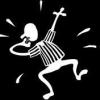
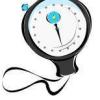
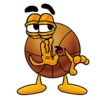
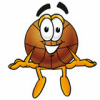
Below are 9 notes clarifying of some rules, after Nigel Wiggins' visit to Rollerblaze games.
1) 3 second key rule - When you risk your 3 second key call, you must attempt to get out of the key with absolutely NO acknowledgement to me directed toward the ball or play. Defense don't have to let you out - however - once the ball has been shot, the ball is deemed a dead ball and all team members, including the player who has been attempting to get out of the key, are allowed to make a play for the ball. It is a risk defense take by locking them in the key where they are then eligible to go for a rebound once the ball has been shot - AS LONG AS THERE HAS BEEN A VALID ATTEMPT TO LEAVE THE KEY!!!
2) On the side line there are 2 options:
3) No offensive player is allowed inside the key when the ball is on the sideline WHILST THE REF HAS THE BALL. Once the action of passing the ball to the player has occurred the ball is live and players are allowed anywhere - remembering that the second that ball is played into the front court!
4) Fouls are called at refs descretion - in order to be clear that you do not cause a foul when defending/offending - ensure your axle is in front of the opposing players when turning. If a players are attempting to collect a ball and player A's chair turns via contact, it could be determined contact made was at the fault of player B - in order to ensure you were there first or left enough time and distance to be cleared of any foul on your part, contact would mean player A only turns slightly or stops against your chair. An obvious change of direction due to contact is generally due to your chair being BEHIND or BESIDE theirs.
5) Backcourt rule - If offense has the ball and are in the frontcourt, if ANYONE from offense was the last to touch the ball as it goes to backcourt, defense must touch the ball first in order to avoid a backcourt call. This includes if the ball accidently comes off an OFFENSIVE players CHAIR and goes backcourt - if offense regain possession then it is a backcourt call. THE EXCEPTION TO THE RULE - free throw line - Once the ball has left the players hands, the ball is 'dead ball' and open for ANYONE to collect.
6) 5 second static possession - When offense have the ball, it can not be static (unplayed - like when a player holds the ball and looks to pass it off) for more then 5 seconds or a penalty is called. In order to avoid the 5 second call, dribble it (classified as playing the ball). No attempt to 'play' the ball will mean change of ball to the opposing team.
7) When taking a shot or passing (basically when both hands are on the ball or reaching for the ball), if there is no attempt to gain control of the chair and stop or avoid contact a charge will be called. This is especially so when taking a shot. Lower classified players tend to use other players to stop once a shot has been made. Control must be had prior to hands leaving the chair or there is a risk of foul upon contact.
8) Head on collisions:
9) Tech violation for wheels lifting vs charge/pushing foul: Apparently there is no call for wheels being lifted off the ground when contact with another player is made - ie: when a player goes hard to get through a gap or hits a player hard when passing/shooting/moving - the call is either a charging foul or blocking foul (that way points for fouls build up against that player). I will clarify at Classics re: the 2 free shots that is then eliminated when changed from violation to foul and what occurrs when a player jumps with the chair.
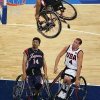
New Ref's Wrap explaining the rules around raising rear wheels off the floor. Click on more
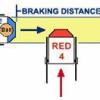
When guarding players, there are 2 rules to remember:
1) If there is no player with the ball, WHO GOT THERE FIRST??
2) If there is a player with the ball, COVER THE PATH and TIME AND DISTANCE(braking distance)
If you are within the breaking distance of a player with the ball and you make contact with that player, contact is at the fault of the defender. Braking distance must be ensured for an offensive player with the ball . (Click on more for example)
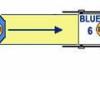
Also, when an offender is heading towards a player who has LEGAL POSITION ... It is the offenders responsibility to avoid contact ... They must expect to be guarded, avoid contact and maintain control of the chair ... Relinquishing control of chair by passing or shooting and contact is made it is offenders responsibility. (Click on more for example)
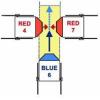
“Closing the gap” describes a situation where two defenders move towards each other to close up a space that an opponent is attempting to wheel through – most of the time this occurs in close proximity to the ring in our games.
Defenders Red 4 and Red 7 are positioned with a space between their chairs that is not big enough for a chair to go through. Opponent Blue 6 tries to push through the space between Red 4 and Red 7. Red 4 and Red 7 each push forwards to close the space even further. Contact occurs between Blue 6 and either one or both of the two defenders.
Decision: Pushing foul by Blue 6 will be called if you continue to push and attempt to get through or forceful contact is made. There was never enough space for Blue 6 to wheel through the gap between Red 4 and Red 7.
The fact that Red 4 and Red 7 closed the gap even further did not change the situation. The original gap was never wide enough for BLUE 6 to fit through without causing contact. THIS IS A CONSTANT ISSUE IN OUR GAMES! (Click on more see diagram enlarged.)
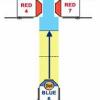
Red 4 and Red 7 are positioned in the path of Blue 6 with enough time and distance provided for Blue 6 to avoid contact. Blue 6 must avoid the legal positions (contact with) Red 4 and Red 7.
Because the defenders have legally occupied a position beyond the braking distance of Blue 6, the defenders do not have to cover the path of Blue 6. Blue 6 has been given time to stop or change direction to avoid contact.
If Red 4 and Red 7 maintain their legal positions, then Blue 6 will be responsible for contact. Even if Red 4 and Red 7 close the gap further when Blue 4 gets within braking distance, Red 4 and Red 7 remain legal because there was never enough room for Blue 4 to get through the gap between Red 4 and Red 7.
Decision: Charging foul by Blue 6 WILL be called. (Click on more see diagram enlarged.)
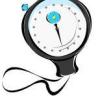
If an offensive player is in the key and does not make an attempt to get out of the key then it is a 3 second key foul ... If the offensive player makes a CONTINUOUS good and fair attempt to get out of the key but is trapped by the defense, a 3 second foul is called if they make any slight attempt to get the ball - if the ball is passed to that player then the player must not even acknowledge the ball or 3 second foul is called as defense have done a good job by locking you out of play minimising the amount of legal players to 4 ... Also watch making any fouls whilst attempting to get out of that key offense ...
